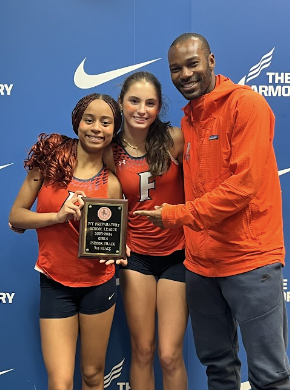As I rounded the curve of my eighth lap, trying to distract myself from my aching lungs and quaking legs, I thought about what track meant to me. The winter track season, a challenging and fulfilling two months of training, running and more, was a central part of my and many of my teammates’ lives. However, in the chaos of winter sports, indoor track is frequently overlooked and forgotten. Thankfully, we have athletic director Gus Ornstein’s emails to remind us of the latest records broken by Mirembe Mubanda (Form VI), Juliette Reed (Form V), Owen Larson (Form VI) and others.
Distance coach Alan Bautista considers track the most rigorous sport. For students running distance, practices consist of a few days of distance running (around 2-5 miles) and a few days of track workouts (anywhere between 150 to 1000 meters.) The coaches record each workout because “it is extremely important that [your times] are recorded to check your progress or lack of progress.” The short-distance runners have extra interval training and less long runs. Both sides of the team incorporate strength and core training, and the coaches provide shot put and long jump instruction to the team members participating in field events.
The track season consists of around 6 Ivy developmental meets, Ivy Prep Championships, NYSAIS and States, in addition to several optional meets. For the coaches, the developmental meets are the chance “to run your best times of the season and to prove your worth and how much you can contribute to the team.”
This year, the team achieved immense success. At Ivy Champs, the girl’s team finished third in Ivy Prep Championships, and many athletes obtained personal records. Additionally, around 20 qualified for NYSAIS. At NYSAIS, three athletes qualified for states, where Juliette Reed (Form V) medaled in the 300 meters, placing 8th.
Owen Larson (Form VI) broke his own school records in the mile, 1000 meter, 3200 meter and two mile; he also won the NYSAIS state championship in the 1600 meter. Juliette Reed (Form V) is a NYSAIS champion in the 55-meter dash and 300-meter sprint, in addition to breaking her own school records in the 400-meter and 200-meter. Additionally, Mirembe Mubanda (Form VI) broke the school record in the 2 mile and 1500 meter, and Davis Williams (V) broke the school’s 55-meter school record. Mubanda and Larson also competed at the Nike Indoor National meet, placing 16th and 3rd respectively.
Other than the Nike Indoor National meet and one meet at the Ocean Breeze track, The Armory, a chaotic 200-meter indoor track in Washington Heights, hosts most races. Considered an epicenter for track and field athletes worldwide, our team loves training and competing in the renowned track.
Source: Sophia Ahmed
Track is not only about competing; for many participants, practice is a time for valuable social interaction, fresh air, exercise and a chance to clear your mind. Jade Reed (Form III) appreciates “when our team is bonding and creating a community within the Fieldton community. Coach Wynton Marsalis echoes Reed’s sentiment and believes the best part of Track is “bringing something in your imagination into a reality.”
Other teammates delight in the physical act of running. Every miserable minute becomes worthwhile during the moments of joy: the pre-race butterflies melting away at the first step, the adrenaline rush when finishing a repeat, the feeling of satisfaction after a long workout and absorbing the beauty of Van Cortlandt during a long run. Running, which requires nothing but a pair of shoes and a place to go, can be very freeing for members of the team.
One of the most liberating aspects of running is the lack of dependency on other people. However, while the solitude of running can be part of the appeal, the individualistic nature of Track and Field can lead to the coaches struggling with team cohesion. In addition, Marsalis states the coaches have concerns about, “Students not committing. There needs to be checks and balances.” Coaches also worry about lack of support at meets and other events and have struggled with teammates leaving meets early, urging them to stay for the relay races. However, for many teammates, the late time of relays makes them unsustainable for weekly participation, causing friction with the coaches. Additionally, the demands of Fieldon’s rigorous coursework can clash with practice time.
Despite this, one of the most crucial aspects of Track is the mentorship from coaches and veteran team members. As Rose Posternak (Form III) puts it, “The coaches are supportive and encourage my growth throughout the season. It is a great environment, where everyone encourages us to become the best version of ourselves.” The team captains, Juliette Reed (Form V), Paloma Hostin (Form VI) and Matthew Kelly (Form VI), also contribute to the positive environment, acting as role models and go-betweens with the coaches.
Track is also unique due to the immense diversity within the team. Students in a varied range of skill levels can join and make meaningful contributions to themselves and the team. Track is also one of the only sports to completely integrate both genders, although girls and boys compete separately.
The next time you see the dedicated runners sprinting around the track, cheer for them; while running may seem simple, being on the track team is anything but.






